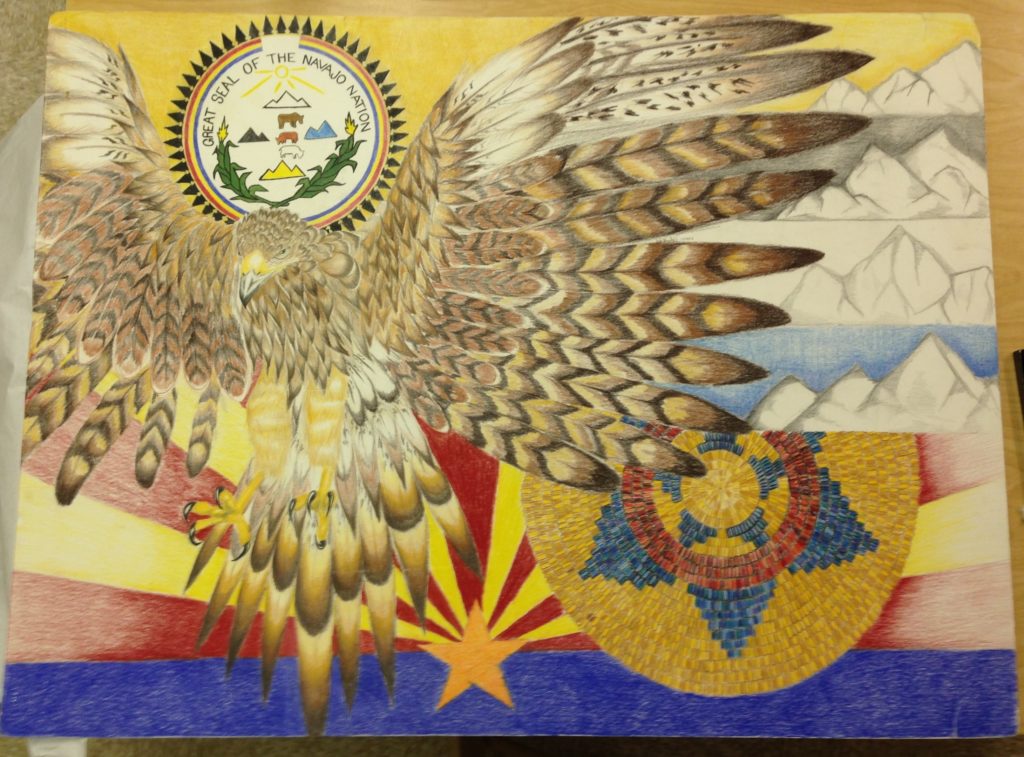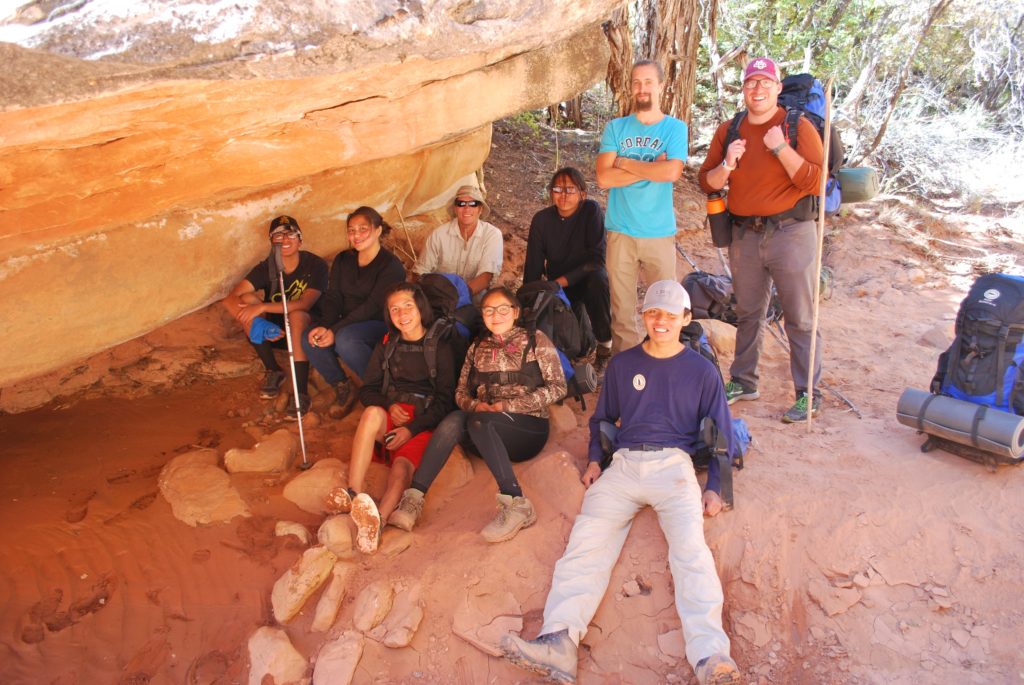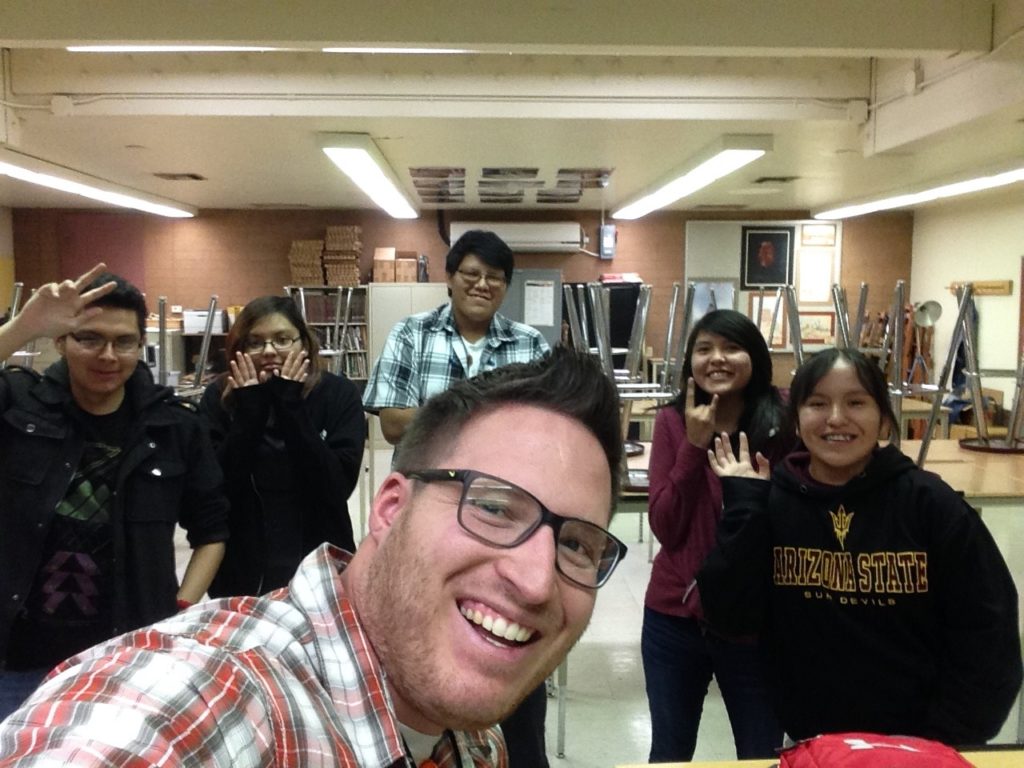
Artwork created by one of Josh Dillinger’s AP Studio Art students, Mykail Benally, Monument Valley High School, Kayenta, Arizona.
The United States Senate Youth Program attracts talented young leaders with wide-ranging passions and ambitions. The common denominator lies in the desire to improve the lives of others. Josh Dillinger (USSYP WY – 2013) has long known that he wanted to be involved in education. Combining his talent and creativity in the visual arts with his desire to serve through education, he became an art teacher on the Navajo Nation after graduating from Colorado Mesa University last spring. Read on to learn what life is like for Josh in this edition of our Alumni Pathways blog.
USSYP: Please tell us about your current role:
Josh: I am the high school art teacher for Monument Valley High School in Kayenta, Arizona. I teach eight different courses including: Drawing I and II, Painting I and II, Ceramics I and II, AP Studio Art: 3D, and AP Studio Art: Drawing. Most of my classes are mixed grade levels giving me the opportunity to work with a wide variety of students at all different skill levels.
USSYP: Have you always had a passion for art?:
Josh: My passion for art has always seemed to be there. From an early age, I wanted to create drawings that were true to the world I was seeing. I still believe that art is the best way to get people to see the world around them. I think that when an artist trains their eye to see something accurately enough to reproduce it on a canvas, they begin to see the world differently. This is what sets creative people apart, they can look at the world and see it in a way most other people don’t; this new vision is what allows creative people to solve problems that other people can’t.
USSYP: When did you know you were interested in teaching?
Josh: My mom was an elementary school PE teacher, so having a parent in education always made it an option, and it was always what I came back to. If you ask almost anyone that got to know me at USSYP, they will probably tell you that even then I had a passion for education. I can recall many amazing conversations my fellow delegates and I had about our education system and what we could do to make it better. A few of us even conspired about creating a private school together.

Josh Dillinger (pictured on far right in orange shirt) with fellow teachers and a group of students on a backpacking trip in October.
USSYP: What have you learned in your nascent career on the Navajo Nation that has been meaningful or illuminating?
Josh: I learned about the reservation from my internship with the Senate Committee on Indian Affairs in 2016, but living on the reservation has given me a new perspective on many issues facing Indian Country. But perhaps the most meaningful experience so far is the experience of being invited in to learn the Navajo culture. I have been trying to learn Navajo (it’s a hard language, I understand now why they were used as the code talkers in World War II), and I often am asking students about the cultural significance of things around us. I have also had the amazing opportunity to go and explore the Navajo’s traditional lands, going out with different families to see the ancient ruins or learning about the different ceremonies my students go through. I am extremely grateful for the chance to learn firsthand about this beautiful culture and I am sure this will continue to be one of the most meaningful parts of my time here.
USSYP: Can you share examples of aspects of the Navajo culture, philosophies or rituals that have had an impact on you?
Josh: I have seen the immense dedication to family and community throughout the culture, which feeds most of the traditions and views held by the Navajo people. For example, the clan system for the Navajo tribe helps define relations to other people. When an individual introduces themselves, they tell you their name and the first clan that their mother, father, maternal grandfather, and paternal grandfather belong to. This gives each person four clans – clans are groups that lived in certain areas before we began recording history, their names translate into English as “Bitter Water Clan” and “Mud Clan,” to name a few. Clans are part of groups (a group consists of any number of clans), and then depending on the connections between one of your clans and another’s, you may be related. For example, if both your mothers had the same clan or extended group, then you are related somehow. The level of connection between the two clans determines the relationship (grandfather, cousin, brother, and so on). So, in Navajo culture, from the moment you first meet someone, you see the importance of family and community. People not only tell you who they are, but whom they belong to, and where they come from. They do this so you can see what you have in common with them, how you are related, and how you both connect to the community. When we find a connection with someone it is easier to help each other and work together to create a better place to live.
This system builds a unified purpose, goal, and vision; and it helps welcome newcomers. For people from another tribe there might be a clan established for them to adopt as they connect with the Navajo, or they might do what some Bilaganna (the Navajo term for white person) do, and adopt the clans of someone whom they have built a strong connection to. The system also connects Navajo to the earth, not only by describing geographically where they live, but because the original clans were in relation to the four directions, which are connected to the four sacred mountains.
The entire system, as you piece together and find the relation between parts of the culture, has impacted me a great deal. It is a beautiful way to think about the world, to find the connection you have with someone as you are introducing yourself and recognize your intertwined past, and inevitably linked future, with those around you. It has taught me to be more cognizant of the world we live in, thinking of the environment we impact daily. Thankfully, much of the teachings of the Navajo survived the boarding schools and assimilation efforts our country imposed on them, because while not everything can translate between cultures, the ideas and much of the way of life the Navajo abide by, are designed to keep a healthy self, tribe, and environment.

Josh Dillinger with students at Monument Valley High School
USSYP: What has been most surprising thus far?
Josh: The most surprising aspect so far has been the relationships I have built with my students. They love to see if I fit the generic white guy stereotypes, and I hate to admit that most of the time I do. We have very light-hearted relationships and I enjoy hearing their questions about what the world is like off the reservation.
USSYP: How do you think you are able to impact young people?
Josh: Many of my students come from rough situations, and I know that when they get to my class they need someone who is there for them. I know that there are many students who have found their escape in my class and through art, and I strive to help them maintain and build that. For many of my students, art is a way to share their story with the world, and the most impactful thing I can do for them is help develop their voice. It is amazing to see students that used to skip school come just because they want to learn more in art. I am lucky that I get to reach students at levels many of my colleagues never do, and I get to see sides of my students that they never share with the world.
USSYP: The art from one of your students that you have shared in the photo (at top) is exquisite – can you tell us more about the art your Navajo students are making?
Josh: For the most part, few of my students practice the traditional art forms (sand-painting, basket weaving, string games, beading, and many more). But, most of my students still have an understanding of the symbols often seen in Navajo artwork and some reflect those in their self-expression in their sketchbooks or when we do culturally inspired pieces. These students often draw Yei (Navajo spirits or deities), and traditional designs. Some of my students design their beadwork projects in their books.
Perhaps most commonly, I see connections to the four sacred mountains, something you can see in the upper right corner of Mykail’s artwork above. Each mountain is related to a cardinal direction with east (the White Mountain) being where you would typically see north; at the top. East carries a lot of weight within the Navajo culture, and within their artwork. Hogans (traditional Navajo dwellings) always have their doors facing east as it is where the new day starts. Sand paintings typically have an opening at the top (again east goes at the top) because Yei (or holy people) come from the east and the opening in the barrier (typically created by a rainbow, another common symbol in Navajo art) allows them in, while keeping evil spirits coming from other directions out. An example of this can be seen in the seal of the Navajo Nation in Mykail’s piece. Seeing high school students who are so knowledgeable in symbolism within art is refreshing, and I am consistently impressed with their ability to integrate that into our drawings throughout the semester.
USSYP: What would you tell others who are interested in this career path?
Josh: Go for it! Education isn’t the most glamorous career. But, if you can stick it out and get into your own classroom, it will be worth it. You will get the chance to shape the future, to impact students who have challenging home lives, and to pass on content that you are passionate about. Don’t decide after one year if teaching is or is not for you, and don’t be scared to take whatever job you can get at the start and work your way to where you want to be over time.
